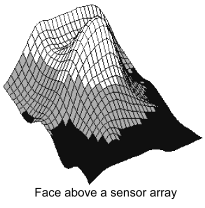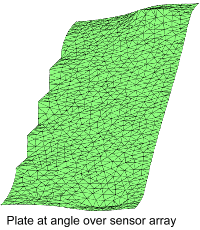|
3d shapes - detection and or measurement
Capacitive and electric field sensing techniques use a sensor array comprising multiple electrodes to obtain data for image mapping. The greater the density of data collected the greater the resolution of the resulting image map.  Radar and Sonar based imaging achieves 2 and 3 dimensional views by multiple views, using the same transducer rather than a sensor array, with each view taken by the transducer separated by a different viewing angle. A characteristic of capacitive and electric field image mapping techniques is non-invasive mapping. Capacitive and electric field sensor arrays can project fields over an air gap which penetrate materials to map objects beneath the surface. This non-invasive mapping is also possible with "ground radar" when close proximity to the surface is achieved.
When capacitive and electric fields are used for image mapping, multiple sense electrodes are typically built into a sensor array where very low parasitic capacitance of each electrode and circuit is required to minimise signal loss.  Processing electronics deal with the multiple inputs from the sensor array to produce an image map of the target which may be intended for human or automatic (machine) evaluation.
If destined for automatic machine evaluation, the sensing and control system must be programmed to interpret the data gathered.
|
